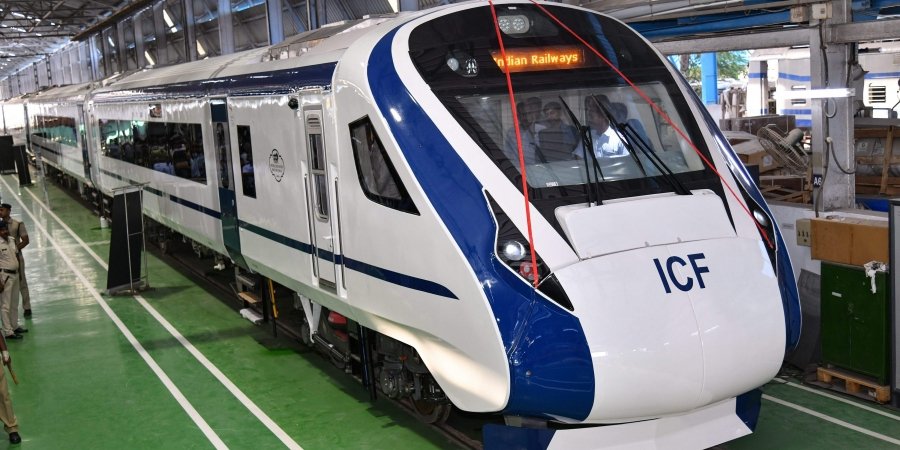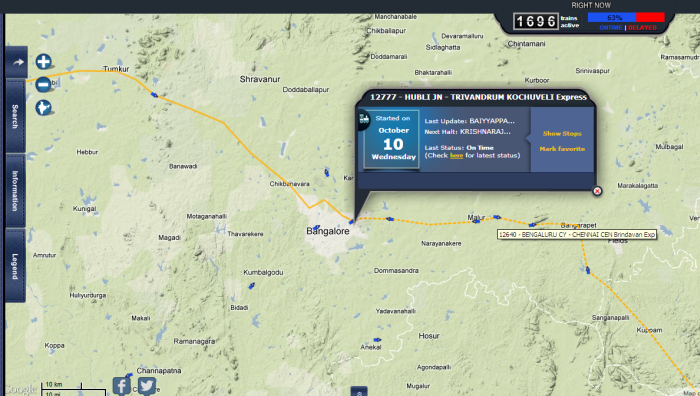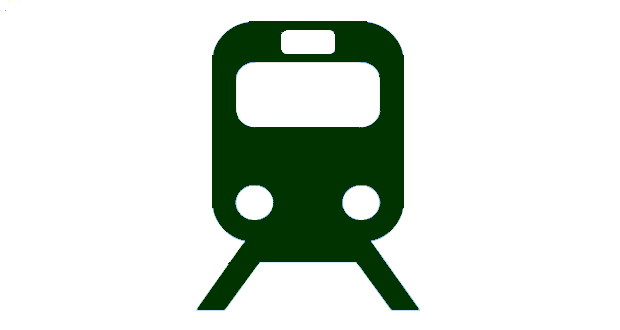Indian Railways Comes of Age With the Train-18 Trainset

Its perfectly machined body glistens under the flash lights. The sleek lines and plush interiors stand apart, unbelonging to its surroundings. The entire train looks like it has descended from some foreign country. Yes, it exists! The unbelievable has happened. The “Train-18” as it was known until now has hit the rails in all its white-and-blue glory. Capable of running at 160 kilometres per hour and featuring several firsts, the revolutionary design of the new train is unlike anything India has seen until now. The looks and feel of the train prompt an immediate likeness of the train with the glamorous ones usually associated with developed countries. And it is all made in India! It has unleashed a storm of disbelief, euphoria and smiling faces ever since its birth as announced by ICF through their social media channels. While most of the coverage for the Train-18 is over the visibly shiny bits like the gleaming exteriors and the swanky interiors and addons like “revolving seats”, not much thought has been given about the significance of the launch of this train and the impact this train will cause in the Indian transportation scene as a whole. They are of course, clueless about the technology and history of how this vehicle came to be, and of course, not giving much credit to the ICF for managing to achieve what no one thought was possible.
We all know how outdated our trains on Indian Railways are. The older ones (ICF coaches – the blue ones) persist as a design unchanged from the early 1960s. The supposedly “modern” LHB coaches (the usually red ones) are not exactly the latest in technology either. They date back to the early 1990s and are already close to 30 years old. However, it is not just the coaches, but our model of a locomotive – engine – though most of our locomotives contain no engines – pulling a consist of coaches itself is outdated as an inefficient and cumbersome model, already done away by most of the world’s railways by the turn of this century in favour the more efficient and profitable “trainset” model, where there are no engines but the entire train propels itself. India is late to this party by a couple of decades, which is why the newly launched “Train-18” is so significant. But it is much, much more than just a pretty face.
What is the Train-18?
The “Train-18” is an Electric Multiple Unit (EMU) trainset. An EMU trainset is a set of coaches semi-permanently coupled together that can run by themselves by directly powering the wheels of the coaches through a distributed transmission and propulsion system and hence does not need a locomotive to run. If you are familiar with the working of locomotives, you will know that locomotives are propelled forward by the means of powerful (AC or DC) electric motors called traction motors attached to their wheel axles. The “body shell” of the locomotive houses all the equipment necessary to receive (for electrics) or generate (for diesels), convert and optimise power supply to traction motors. In EMU trainsets like the Train-18, the locomotive is (simply put) broken down into multiple pieces or units distributed throughout among a number of coaches. The wheels of some coaches are directly fitted with traction motors (called motor cars) and all the converting and optimising equipment present in the locomotive are “hidden away” under the floor of on the roof of the passenger coaches (power cars or trailer cars). While in an ordinary train the locomotive alone does all the pulling, in an EMU trainset many coaches will work together to move the train. A train set will consist of a number of such “disassembled locomotives”, a set of coaches of which is called an electrical unit. The Train-18 has four such electrical units, each of which will have two motor coaches and to trailer coaches.
Train-18 is not by any means Indian Railway’s first “engineless train” as our media claim. Our local trains (EMUs, MEMUs, DEMUs) are all “engineless” multiple units. However, there is a difference. The Train-18 is a power-distributed system where powered coaches are distributed throughout the train. In comparison, our present multiple units are power-centralised systems. They have powered coaches at the front and back of the train only, making it equivalent to having locos at the front and back. The advantages of a power-distributed system are many, including faster acceleration and braking, efficient usage of power, lesser vehicle weight and axle load and hence track wear and tear. But more importantly, in the absence of locomotives and power cars and traction equipment occupying space, the entire train is revenue-generating, or its full area is available to house passengers. Metro trains can be said to be true EMU trainsets.
The Train-18 is intended to replace Shatabdi Expresses. The first Train-18 will mostly replace the LHB rakes of the prestigious New Delhi – Bhopal – New Delhi “The King” Shatabdi. Train-18 trainsets are built to run at 180 kph which is the upper possible limit with our current tracks and signalling systems, but will run operationally at a maximum speed of 160 kph only. The media might not be able to stop gushing about the “revolving” chairs (in First Class) as some great invention, but it is only one novelty among a lot many. And the revolving chairs mean that the chairs will always face the direction of travel. Deserving much more accolades are things like the design of the doors, vestibules and fully sealed gangways and the adaptation of the CB Couplers into semi-permanent connectors, the successful underslinging of traction equipment and above all, providing great fit and finish to the coaches and other major features like regenerative braking. Still, all these technicalities might feel irrelevant to a large majority of people who wouldn’t want to know about anything but the creature comforts on the train and how plush and swanky it looks. There has been much gushing about the revolving chairs, but the train consists of much more aesthetic appeal-gaining factors that make it look out-of-place among today’s other trains in India, and would certainly impress those who shun trains because they aren’t as aesthetically pleasing and modern as trains and planes. Some of those factors are:
Exterior
- Stainless-steel body
- Euro train colour scheme (white)
- Aerodynamic driving cab ends on both sides
- Fully digital destination boards embedded in the coach body
- Fully sealed gangways with continuous bellows flush to the coach body
- Continuous bezel-less windows on the outside. The windows still have bezels or opaque dividing frames in the inside which are quite wide, and some seats are positioned next to those with no outside visibility
- Automatic doors: The doors fit flush on the body and swing outwards, controlled from the driving cabin. All doors open only after the train has come to a complete stop and won’t depart until the doors are fully closed. The doors will also have a “bridge” that extends from under the door to help passengers over any platform gaps. Automatic doors are already in place on the Gatimaan and Tejas expresses.
Interiors
- Interior walls are all cladded and feature a soothing and pleasing light colour scheme.
- Coach entry and vestibules feature touch-automatic sliding glass doors
- Gangway (passage between coaches) is fully sealed. This means there is no way for dust to get into the train.
- Individual reading lights above all seats
- Fixed-back reclining seats, the kind you see in movie theaters where the seat slides forward.
- Precisely and thoughfully engineered seats involving design experts from several countries.
- Modular luggage racks with a glass base
- Diffused LED lighting. Only LEDs are being throughout the train.
- Centralised climate controlled smart airconditioning
- GPS-based passenger information systems
- WiFi throughout the train
- Intercom and pubic announcement system
- Vastly improved toilets with bio-vacuum commodes and sensor taps
- Larger doors and completely redesigned spacious and pleasing vestibules
- Train is disabled-friendly and wheelchair accessible
- Individual mobile charging points underneath every seat
The Indian Railways had been looking to acquire trainsets for quite a long time. After its global tender for 10 trainsets of 20 coaches each was shunned by international giants who wanted to build atleast 5 times the number of coaches, IR decided we could build the train themselves. The Integral Coach Factory at Chennai as assigned the task in early 2017. No one thought this marvel of a train would hit the rails just 36 months later and at a cost of just 100 crores! People do not seem to appreciate how stupendous and achievement this is. The Train-18 is the FIRST indigenously designed and built railway vehicle in India, ever. Just until three years back, ICF was churning out the old blue dabbas from the 1960s through what can be called effectively a copy-paste operation. ICF was never held in much high regard despite the number of coaches it produced. Most of their new LHB ones were notorious for their poor workmaship and finish. Today, it has produced, by itself, a trainset that can match up to any of the world’s best and greatest in terms of aesthetics, quality and technology! An incredible feat indeed! All kudos to the team at ICF led by its General Manager. Standing ovation, sirs! What an achievement. Our vision for ICF should be to be counted among the world’s greatest train-producers, at par to giants like Siemens, Alstom, Kawasaki etc.

The best part of Train-18 is that ICF designed it to especially suit Indian market conditions. ICF’s experience of more than half a century of building people carriers for Indian Railways reflects in every aspect of Train-18’s design. It hits the sweet spot balancing aesthetics and capacity, focusing on practicality and functionality rather than on bells and whistles. The design exudes a no-nonsense air, emphasing what Indian Railways is good at and meant to be doing – transporting as many people as possible. This is evidenced by the train’s seating capacity of 1154 people which is more than the present Shatabdi Express! This is exactly what Indian Railways needs. It can be said that the Train 18 is the result and outcome of the decades of research, design, evolution and expertise of the Indian Railways, ICF and RDSO, the culmination of all their learning. The coach shells and Center Buffer Coupling are derived from the LHB coaches; the “bezel-less” windows first appeared on a third AC coach manufactured at ICF; the automatically closing doors were previously launched on the Gatimaan and Tejas Express; the revolving seats were first introduced on the Vistadome coaches and so on. The train-18 marks a cultural shift and the next step in the evolution of the Indian Railways. It signals that the organisation has left behind its methods of rolling out trains by changing colours of vinyl wraps and has started to think about real change. Maybe it is because of competition from air and road where planes, buses and cars are much more faster, modern and comfortable than our trains, because when consumers taste the good, they will not go back to the bad.
Atleast for the sake of its’ premium passengers, Indian Railways cannot be seen to operate creaking ICF coaches alongside the gleaming Train-18 anymore. The quality of its other rakes also will have to improve. The train 18 has the potential to do to rail travel what Volvos did to buses. Going forward, the Train-18 and its sister the Train-20 should become the new standard on Indian Railways, just like the LHB coaches. Going forward, a goal should be set for trainsets to replace every Shatabdi and Rajdhani at first and every AC express later on. Maybe we can even think of a non-AC trainset! Given its stellar record in standardised mass production, ICF should have no problem in rolling out trainset coaches in large numbers. There could be a number of modifications to the train, though. The undercarriage of the train is still open exposing everything just like our present-day coaches. They should be covered using a fairing, giving the machinery better protection while also improving aerodynamics and aesthetics. The front-end design could be better. There seem to be a lot of panel gaps inside the train which could be taken care of. The window frames inside the train should be made narrower Some more suggestions could be forthcoming only after experiencing the train first hand. Hopefully Train-18 will be Indian Railway’s coming of age.
Train-18 Technical Specifications
- 16 coach power-distributed Electrical Multiple Unit trainset with driving cabs at either end.
- Axle Load: 17t | Max Speed: 180 kph | Rated Power Output: 8064 kW (10840 hp) – Exactly two WAP5s
- Driving Trailer Coaches: 2, Motor Coaches: 8, Trailer Coaches: 6.
- Coach Configuration: Driving Trailer Car – Motor Car – Trailer Car – Motor Car – 2x (Trailer Car – Motor Car – Trailer Car – Motor Car) – Motor Car – Trailer Car – Motor Car – Driving Trailer Car.
- Coach Composition: 12 full AC Chair Car (78 seats), 2 end AC Chair Cars (44 seats), 2 AC Executive Chair Cars (52 seats)
- Total Seating Capacity: 1154 : 1024 AC Chair Car – Second Class, 104 AC Executive Chair Car – First Class.
- Pantographs: 4, 2 will be operational at any time.
- Bogies: 32, Axles: 64. | Powered Bogies: 16, Powered Axles: 32.
- Drive: 32 252 kW 3-phase asynchronous AC axle-hung, fully suspended traction (induction) motors powering as many axles on 16 bogies controlled by Insulated Gate Bipolar Transistors (IGBT) VVVF drive and microprocessors.
- Regenerative Braking: Kinetic energy generated while braking is converted into electrical energy and fed back to the power grid.
- 30% faster acceleration and deceleration compared to normal trains leading to 15% saving in running time.
PS: A long time ago, Indian Railways promised a rail coach factory at Kanjikode near Palakkad in Kerala. 10 years after around 300 acres of land was acquired to set up said factory, nothing has happened yet. Maybe Indian Railways can utilise that land to set up a facility (ICF subsidiary) to exclusively manufacture trainsets?
And for Shikansen’s sake, stop saying “aircraft-like facilities”! When someone says that, all I can imagine is cramped seats, backache, bloated feet, dry skin and throat, toilet queues, bad food, stale air and that feeling of claustrophobia and captivity. Planes are the most uncomfortable means of travel imagined by humans. I wait for the day when someone says of a plane to have “train-like-facilities”.




